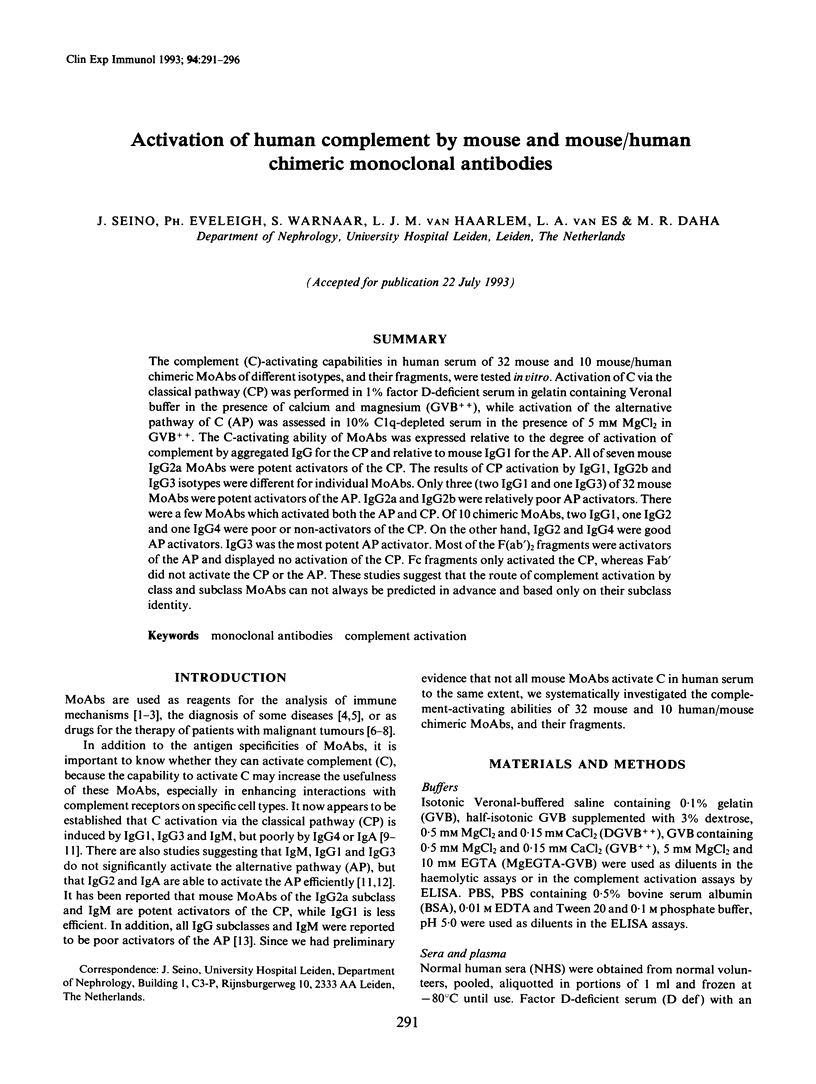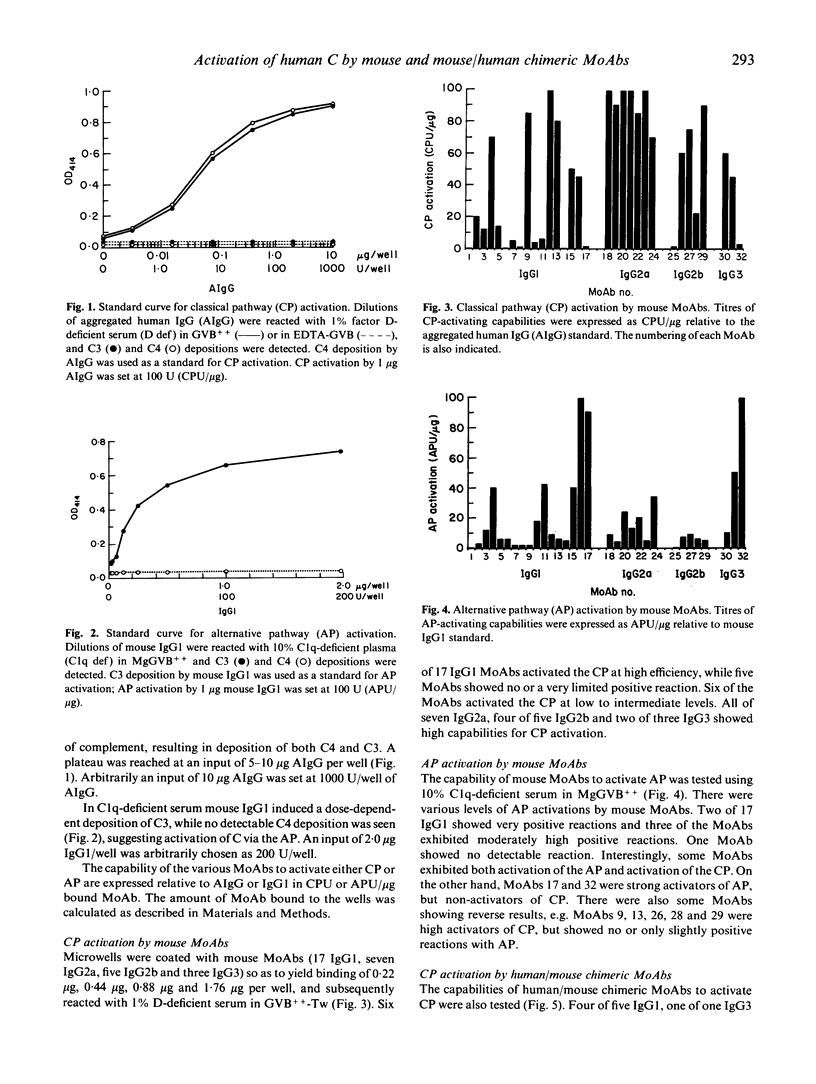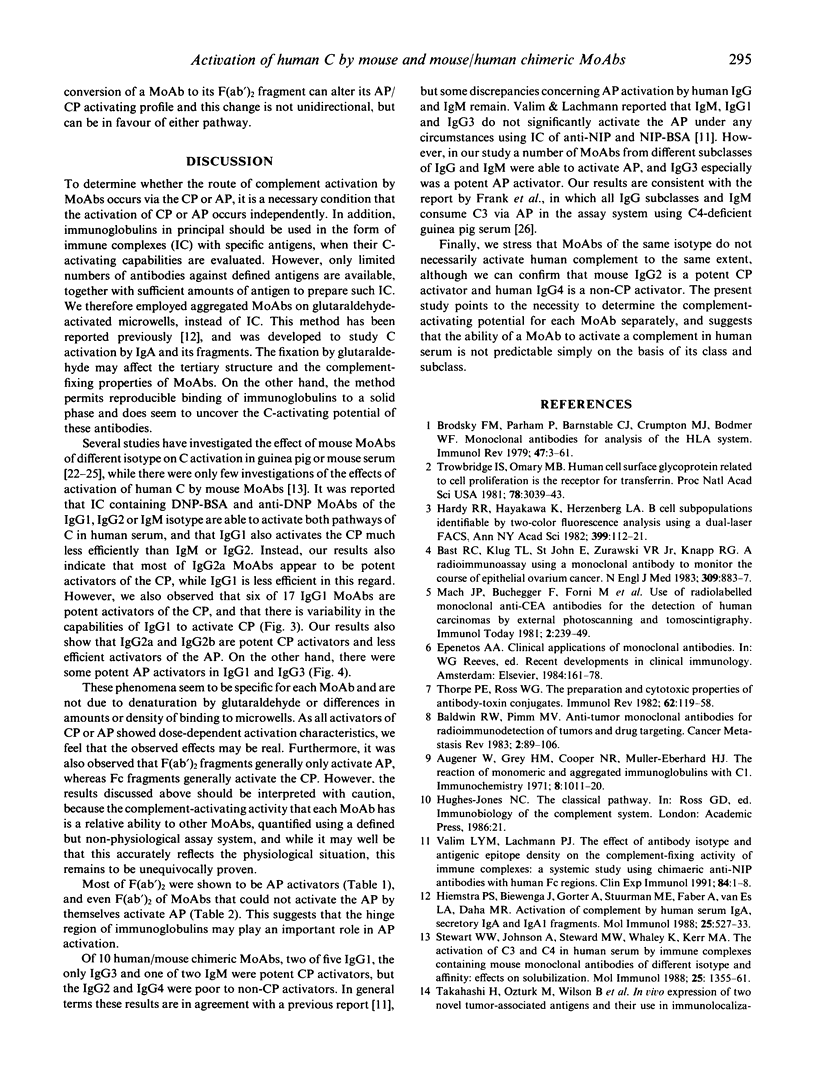Abstract
The complement (C)-activating capabilities in human serum of 32 mouse and 10 mouse/human chimeric MoAbs of different isotypes, and their fragments, were tested in vitro. Activation of C via the classical pathway (CP) was performed in 1% factor D-deficient serum in gelatin containing Veronal buffer in the presence of calcium and magnesium (GVB++), while activation of the alternative pathway of C (AP) was assessed in 10% C1q-depleted serum in the presence of 5 mM MgCl2 in GVB++. The C-activating ability of MoAbs was expressed relative to the degree of activation of complement by aggregated IgG for the CP and relative to mouse IgG1 for the AP. All of seven mouse IgG2a MoAbs were potent activators of the CP. The results of CP activation by IgG1, IgG2b and IgG3 isotypes were different for individual MoAbs. Only three (two IgG1 and one IgG3) of 32 mouse MoAbs were potent activators of the AP. IgG2a and IgG2b were relatively poor AP activators. There were a few MoAbs which activated both the AP and CP. Of 10 chimeric MoAbs, two IgG1, one IgG2 and one IgG4 were poor or non-activators of the CP. On the other hand, IgG2 and IgG4 were good AP activators. IgG3 was the most potent AP activator. Most of the F(ab')2 fragments were activators of the AP and displayed no activation of the CP. Fc fragments only activated the CP, whereas Fab' did not activate the CP or the AP. These studies suggest that the route of complement activation by class and subclass MoAbs can not always be predicted in advance and based only on their subclass identity.
Full text
PDF





Selected References
These references are in PubMed. This may not be the complete list of references from this article.
- Augener W., Grey H. M., Cooper N. R., Müller-Eberhard H. J. The reaction of monomeric and aggregated immunoglobulins with C1. Immunochemistry. 1971 Nov;8(11):1011–1020. doi: 10.1016/0019-2791(71)90489-7. [DOI] [PubMed] [Google Scholar]
- Baldwin R. W., Pimm M. V. Antitumor monoclonal antibodies for radioimmunodetection of tumors and drug targeting. Cancer Metastasis Rev. 1983;2(1):89–106. doi: 10.1007/BF00046907. [DOI] [PubMed] [Google Scholar]
- Bast R. C., Jr, Klug T. L., St John E., Jenison E., Niloff J. M., Lazarus H., Berkowitz R. S., Leavitt T., Griffiths C. T., Parker L. A radioimmunoassay using a monoclonal antibody to monitor the course of epithelial ovarian cancer. N Engl J Med. 1983 Oct 13;309(15):883–887. doi: 10.1056/NEJM198310133091503. [DOI] [PubMed] [Google Scholar]
- Brodsky F. M., Parham P., Barnstable C. J., Crumpton M. J., Bodmer W. F. Monoclonal antibodies for analysis of the HLA system. Immunol Rev. 1979;47:3–61. doi: 10.1111/j.1600-065x.1979.tb00288.x. [DOI] [PubMed] [Google Scholar]
- Edwards D. P., Grzyb K. T., Dressler L. G., Mansel R. E., Zava D. T., Sledge G. W., Jr, McGuire W. L. Monoclonal antibody identification and characterization of a Mr 43,000 membrane glycoprotein associated with human breast cancer. Cancer Res. 1986 Mar;46(3):1306–1317. [PubMed] [Google Scholar]
- Ey P. L., Prowse S. J., Jenkin C. R. Complement-fixing IgG1 constitutes a new subclass of mouse IgG. Nature. 1979 Oct 11;281(5731):492–493. doi: 10.1038/281492a0. [DOI] [PubMed] [Google Scholar]
- Hardy R. R., Hayakawa K., Haaijman J., Herzenberg L. A. B-cell subpopulations identifiable by two-color fluorescence analysis using a dual-laser FACS. Ann N Y Acad Sci. 1982;399:112–121. doi: 10.1111/j.1749-6632.1982.tb25667.x. [DOI] [PubMed] [Google Scholar]
- Herlyn M., Steplewski Z., Herlyn D., Koprowski H. Colorectal carcinoma-specific antigen: detection by means of monoclonal antibodies. Proc Natl Acad Sci U S A. 1979 Mar;76(3):1438–1442. doi: 10.1073/pnas.76.3.1438. [DOI] [PMC free article] [PubMed] [Google Scholar]
- Hiemstra P. S., Biewenga J., Gorter A., Stuurman M. E., Faber A., van Es L. A., Daha M. R. Activation of complement by human serum IgA, secretory IgA and IgA1 fragments. Mol Immunol. 1988 Jun;25(6):527–533. doi: 10.1016/0161-5890(88)90074-0. [DOI] [PubMed] [Google Scholar]
- Hirayama N., Hirano T., Köhler G., Kurata A., Okumura K., Ovary Z. Biological activities of antitrinitrophenyl and antidinitrophenyl mouse monoclonal antibodies. Proc Natl Acad Sci U S A. 1982 Jan;79(2):613–615. doi: 10.1073/pnas.79.2.613. [DOI] [PMC free article] [PubMed] [Google Scholar]
- Khaw B. A., Mattis J. A., Melincoff G., Strauss H. W., Gold H. K., Haber E. Monoclonal antibody to cardiac myosin: imaging of experimental myocardial infarction. Hybridoma. 1984;3(1):11–23. doi: 10.1089/hyb.1984.3.11. [DOI] [PubMed] [Google Scholar]
- Lucisano Valim Y. M., Lachmann P. J. The effect of antibody isotype and antigenic epitope density on the complement-fixing activity of immune complexes: a systematic study using chimaeric anti-NIP antibodies with human Fc regions. Clin Exp Immunol. 1991 Apr;84(1):1–8. doi: 10.1111/j.1365-2249.1991.tb08115.x. [DOI] [PMC free article] [PubMed] [Google Scholar]
- Miotti S., Canevari S., Ménard S., Mezzanzanica D., Porro G., Pupa S. M., Regazzoni M., Tagliabue E., Colnaghi M. I. Characterization of human ovarian carcinoma-associated antigens defined by novel monoclonal antibodies with tumor-restricted specificity. Int J Cancer. 1987 Mar 15;39(3):297–303. doi: 10.1002/ijc.2910390306. [DOI] [PubMed] [Google Scholar]
- Neuberger M. S., Rajewsky K. Activation of mouse complement by monoclonal mouse antibodies. Eur J Immunol. 1981 Dec;11(12):1012–1016. doi: 10.1002/eji.1830111212. [DOI] [PubMed] [Google Scholar]
- Platts-Mills T. A., Ishizaka K. Activation of the alternate pathway of human complements by rabbit cells. J Immunol. 1974 Jul;113(1):348–358. [PubMed] [Google Scholar]
- Skogh T., Hed J., Stendahl O. Complement-mediated inhibition of non-specific aggregation of highly-dinitrophenyl-conjugated human serum albumin. Immunol Commun. 1982;11(5):337–344. doi: 10.3109/08820138209050733. [DOI] [PubMed] [Google Scholar]
- Stewart W. W., Johnson A., Steward M. W., Whaley K., Kerr M. A. The activation of C3 and C4 in human serum by immune complexes containing mouse monoclonal antibodies of different isotype and affinity: effects on solubilisation. Mol Immunol. 1988 Dec;25(12):1355–1361. doi: 10.1016/0161-5890(88)90051-x. [DOI] [PubMed] [Google Scholar]
- Takahashi H., Ozturk M., Wilson B., Maki A., Ozawa K., Koizumi M., Endo K., Strauss W., Shouval D., Wands J. In vivo expression of two novel tumor-associated antigens and their use in immunolocalization of human hepatocellular carcinoma. Hepatology. 1989 Apr;9(4):625–634. doi: 10.1002/hep.1840090419. [DOI] [PubMed] [Google Scholar]
- Thorpe P. E., Ross W. C. The preparation and cytotoxic properties of antibody-toxin conjugates. Immunol Rev. 1982;62:119–158. doi: 10.1111/j.1600-065x.1982.tb00392.x. [DOI] [PubMed] [Google Scholar]
- Trowbridge I. S., Omary M. B. Human cell surface glycoprotein related to cell proliferation is the receptor for transferrin. Proc Natl Acad Sci U S A. 1981 May;78(5):3039–3043. doi: 10.1073/pnas.78.5.3039. [DOI] [PMC free article] [PubMed] [Google Scholar]


